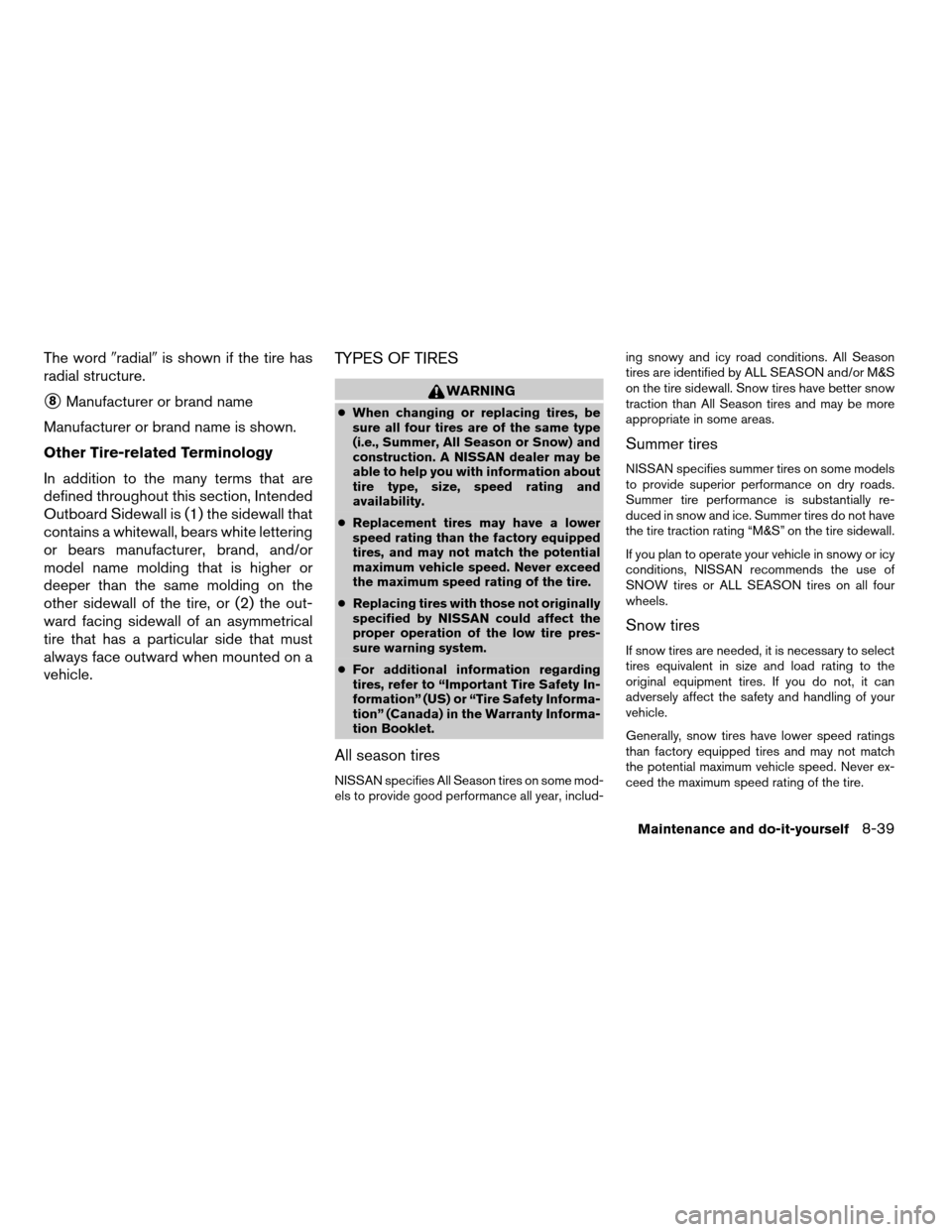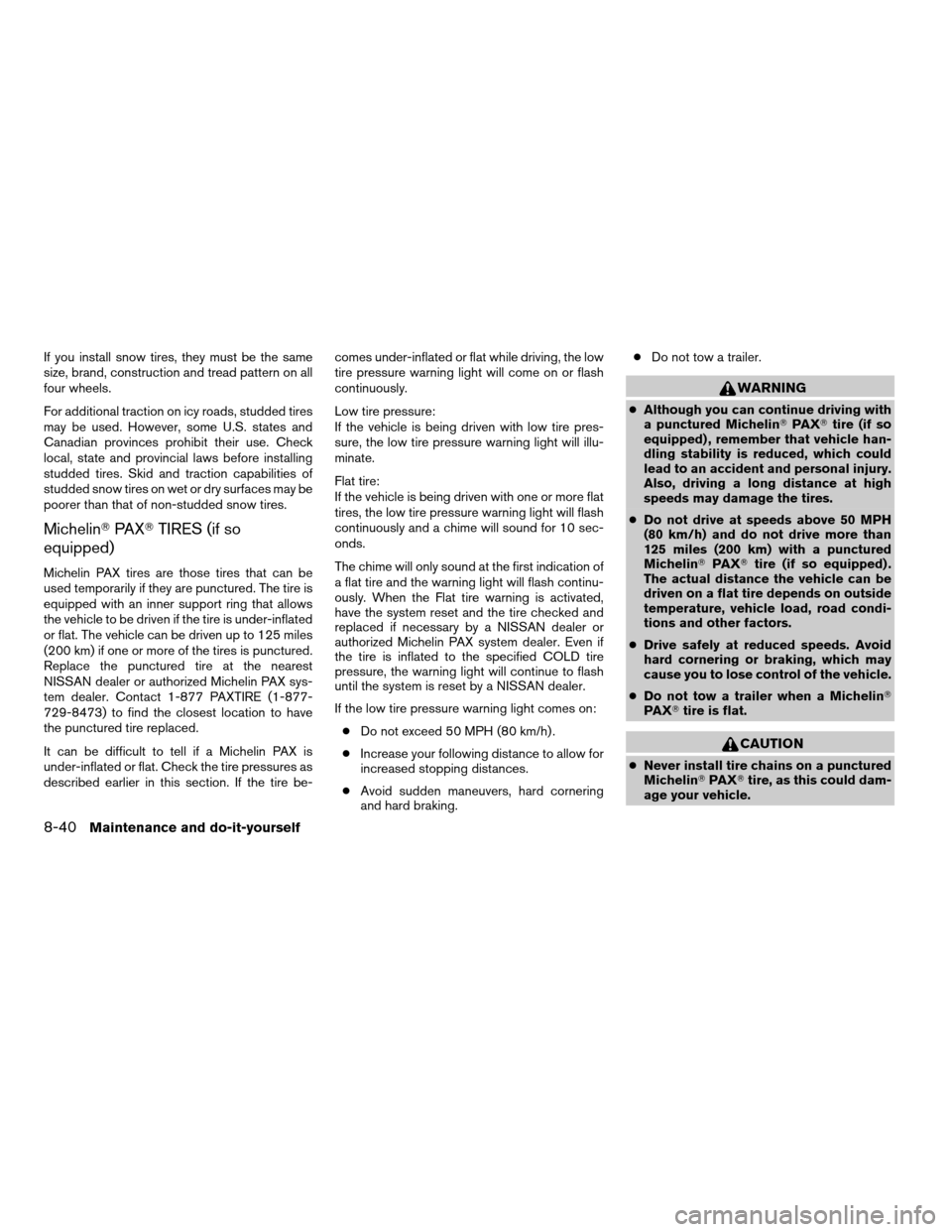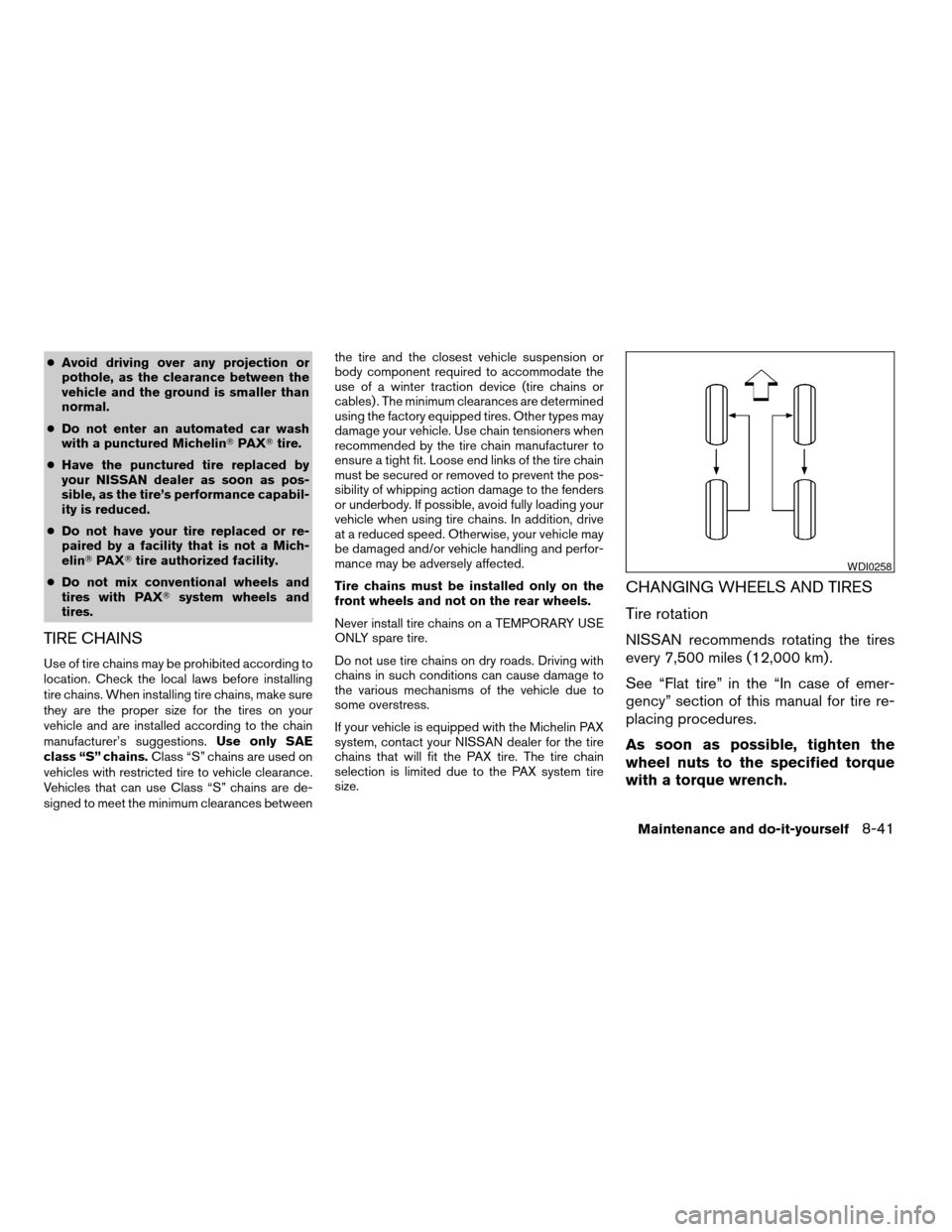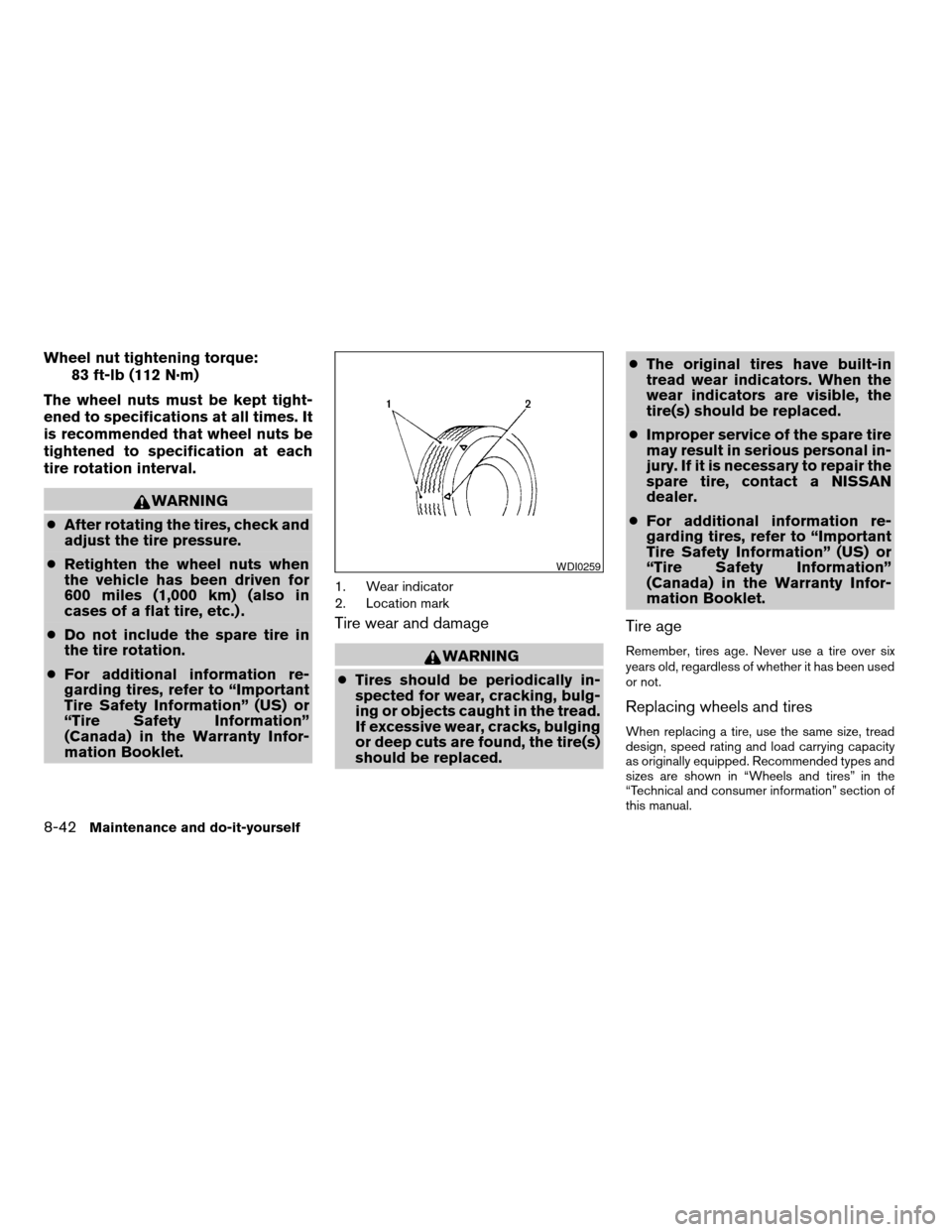2006 NISSAN QUEST wheel size
[x] Cancel search: wheel sizePage 309 of 352

The word9radial9is shown if the tire has
radial structure.
s8Manufacturer or brand name
Manufacturer or brand name is shown.
Other Tire-related Terminology
In addition to the many terms that are
defined throughout this section, Intended
Outboard Sidewall is (1) the sidewall that
contains a whitewall, bears white lettering
or bears manufacturer, brand, and/or
model name molding that is higher or
deeper than the same molding on the
other sidewall of the tire, or (2) the out-
ward facing sidewall of an asymmetrical
tire that has a particular side that must
always face outward when mounted on a
vehicle.
TYPES OF TIRES
WARNING
cWhen changing or replacing tires, be
sure all four tires are of the same type
(i.e., Summer, All Season or Snow) and
construction. A NISSAN dealer may be
able to help you with information about
tire type, size, speed rating and
availability.
cReplacement tires may have a lower
speed rating than the factory equipped
tires, and may not match the potential
maximum vehicle speed. Never exceed
the maximum speed rating of the tire.
cReplacing tires with those not originally
specified by NISSAN could affect the
proper operation of the low tire pres-
sure warning system.
cFor additional information regarding
tires, refer to “Important Tire Safety In-
formation” (US) or “Tire Safety Informa-
tion” (Canada) in the Warranty Informa-
tion Booklet.
All season tires
NISSAN specifies All Season tires on some mod-
els to provide good performance all year, includ-ing snowy and icy road conditions. All Season
tires are identified by ALL SEASON and/or M&S
on the tire sidewall. Snow tires have better snow
traction than All Season tires and may be more
appropriate in some areas.
Summer tires
NISSAN specifies summer tires on some models
to provide superior performance on dry roads.
Summer tire performance is substantially re-
duced in snow and ice. Summer tires do not have
the tire traction rating “M&S” on the tire sidewall.
If you plan to operate your vehicle in snowy or icy
conditions, NISSAN recommends the use of
SNOW tires or ALL SEASON tires on all four
wheels.
Snow tires
If snow tires are needed, it is necessary to select
tires equivalent in size and load rating to the
original equipment tires. If you do not, it can
adversely affect the safety and handling of your
vehicle.
Generally, snow tires have lower speed ratings
than factory equipped tires and may not match
the potential maximum vehicle speed. Never ex-
ceed the maximum speed rating of the tire.
Maintenance and do-it-yourself8-39
ZREVIEW COPYÐ2006 Quest(van)
Owners ManualÐUSA_English(nna)
05/27/05Ðtbrooks
X
Page 310 of 352

If you install snow tires, they must be the same
size, brand, construction and tread pattern on all
four wheels.
For additional traction on icy roads, studded tires
may be used. However, some U.S. states and
Canadian provinces prohibit their use. Check
local, state and provincial laws before installing
studded tires. Skid and traction capabilities of
studded snow tires on wet or dry surfaces may be
poorer than that of non-studded snow tires.
MichelinTPAXTTIRES (if so
equipped)
Michelin PAX tires are those tires that can be
used temporarily if they are punctured. The tire is
equipped with an inner support ring that allows
the vehicle to be driven if the tire is under-inflated
or flat. The vehicle can be driven up to 125 miles
(200 km) if one or more of the tires is punctured.
Replace the punctured tire at the nearest
NISSAN dealer or authorized Michelin PAX sys-
tem dealer. Contact 1-877 PAXTIRE (1-877-
729-8473) to find the closest location to have
the punctured tire replaced.
It can be difficult to tell if a Michelin PAX is
under-inflated or flat. Check the tire pressures as
described earlier in this section. If the tire be-comes under-inflated or flat while driving, the low
tire pressure warning light will come on or flash
continuously.
Low tire pressure:
If the vehicle is being driven with low tire pres-
sure, the low tire pressure warning light will illu-
minate.
Flat tire:
If the vehicle is being driven with one or more flat
tires, the low tire pressure warning light will flash
continuously and a chime will sound for 10 sec-
onds.
The chime will only sound at the first indication of
a flat tire and the warning light will flash continu-
ously. When the Flat tire warning is activated,
have the system reset and the tire checked and
replaced if necessary by a NISSAN dealer or
authorized Michelin PAX system dealer. Even if
the tire is inflated to the specified COLD tire
pressure, the warning light will continue to flash
until the system is reset by a NISSAN dealer.
If the low tire pressure warning light comes on:
cDo not exceed 50 MPH (80 km/h) .
cIncrease your following distance to allow for
increased stopping distances.
cAvoid sudden maneuvers, hard cornering
and hard braking.cDo not tow a trailer.
WARNING
cAlthough you can continue driving with
a punctured MichelinTPAXTtire (if so
equipped) , remember that vehicle han-
dling stability is reduced, which could
lead to an accident and personal injury.
Also, driving a long distance at high
speeds may damage the tires.
cDo not drive at speeds above 50 MPH
(80 km/h) and do not drive more than
125 miles (200 km) with a punctured
MichelinTPAXTtire (if so equipped) .
The actual distance the vehicle can be
driven on a flat tire depends on outside
temperature, vehicle load, road condi-
tions and other factors.
cDrive safely at reduced speeds. Avoid
hard cornering or braking, which may
cause you to lose control of the vehicle.
cDo not tow a trailer when a MichelinT
PAXTtire is flat.
CAUTION
cNever install tire chains on a punctured
MichelinTPAXTtire, as this could dam-
age your vehicle.
8-40Maintenance and do-it-yourself
ZREVIEW COPYÐ2006 Quest(van)
Owners ManualÐUSA_English(nna)
05/27/05Ðtbrooks
X
Page 311 of 352

cAvoid driving over any projection or
pothole, as the clearance between the
vehicle and the ground is smaller than
normal.
cDo not enter an automated car wash
with a punctured MichelinTPAXTtire.
cHave the punctured tire replaced by
your NISSAN dealer as soon as pos-
sible, as the tire’s performance capabil-
ity is reduced.
cDo not have your tire replaced or re-
paired by a facility that is not a Mich-
elinTPAXTtire authorized facility.
cDo not mix conventional wheels and
tires with PAXTsystem wheels and
tires.
TIRE CHAINS
Use of tire chains may be prohibited according to
location. Check the local laws before installing
tire chains. When installing tire chains, make sure
they are the proper size for the tires on your
vehicle and are installed according to the chain
manufacturer’s suggestions.Use only SAE
class “S” chains.Class “S” chains are used on
vehicles with restricted tire to vehicle clearance.
Vehicles that can use Class “S” chains are de-
signed to meet the minimum clearances betweenthe tire and the closest vehicle suspension or
body component required to accommodate the
use of a winter traction device (tire chains or
cables) . The minimum clearances are determined
using the factory equipped tires. Other types may
damage your vehicle. Use chain tensioners when
recommended by the tire chain manufacturer to
ensure a tight fit. Loose end links of the tire chain
must be secured or removed to prevent the pos-
sibility of whipping action damage to the fenders
or underbody. If possible, avoid fully loading your
vehicle when using tire chains. In addition, drive
at a reduced speed. Otherwise, your vehicle may
be damaged and/or vehicle handling and perfor-
mance may be adversely affected.
Tire chains must be installed only on the
front wheels and not on the rear wheels.
Never install tire chains on a TEMPORARY USE
ONLY spare tire.
Do not use tire chains on dry roads. Driving with
chains in such conditions can cause damage to
the various mechanisms of the vehicle due to
some overstress.
If your vehicle is equipped with the Michelin PAX
system, contact your NISSAN dealer for the tire
chains that will fit the PAX tire. The tire chain
selection is limited due to the PAX system tire
size.
CHANGING WHEELS AND TIRES
Tire rotation
NISSAN recommends rotating the tires
every 7,500 miles (12,000 km) .
See “Flat tire” in the “In case of emer-
gency” section of this manual for tire re-
placing procedures.
As soon as possible, tighten the
wheel nuts to the specified torque
with a torque wrench.
WDI0258
Maintenance and do-it-yourself8-41
ZREVIEW COPYÐ2006 Quest(van)
Owners ManualÐUSA_English(nna)
05/27/05Ðtbrooks
X
Page 312 of 352

Wheel nut tightening torque:
83 ft-lb (112 N·m)
The wheel nuts must be kept tight-
ened to specifications at all times. It
is recommended that wheel nuts be
tightened to specification at each
tire rotation interval.
WARNING
cAfter rotating the tires, check and
adjust the tire pressure.
cRetighten the wheel nuts when
the vehicle has been driven for
600 miles (1,000 km) (also in
cases of a flat tire, etc.) .
cDo not include the spare tire in
the tire rotation.
cFor additional information re-
garding tires, refer to “Important
Tire Safety Information” (US) or
“Tire Safety Information”
(Canada) in the Warranty Infor-
mation Booklet.
1. Wear indicator
2. Location mark
Tire wear and damage
WARNING
cTires should be periodically in-
spected for wear, cracking, bulg-
ing or objects caught in the tread.
If excessive wear, cracks, bulging
or deep cuts are found, the tire(s)
should be replaced.cThe original tires have built-in
tread wear indicators. When the
wear indicators are visible, the
tire(s) should be replaced.
cImproper service of the spare tire
may result in serious personal in-
jury. If it is necessary to repair the
spare tire, contact a NISSAN
dealer.
cFor additional information re-
garding tires, refer to “Important
Tire Safety Information” (US) or
“Tire Safety Information”
(Canada) in the Warranty Infor-
mation Booklet.
Tire age
Remember, tires age. Never use a tire over six
years old, regardless of whether it has been used
or not.
Replacing wheels and tires
When replacing a tire, use the same size, tread
design, speed rating and load carrying capacity
as originally equipped. Recommended types and
sizes are shown in “Wheels and tires” in the
“Technical and consumer information” section of
this manual.
WDI0259
8-42Maintenance and do-it-yourself
ZREVIEW COPYÐ2006 Quest(van)
Owners ManualÐUSA_English(nna)
05/27/05Ðtbrooks
X
Page 344 of 352

Precautions when starting and driving . . .5-2
Push starting.................6-9
Starting the engine..............5-9
Startup Screen
Control panel buttons...........4-17
Startup screen display.............4-17
Steering
Power steering fluid.............8-13
Power steering system...........5-18
Tilting steering wheel............3-20
Steering wheel audio control switch......4-51
Stop light....................8-28
Storage.....................2-27
Storage bin.........2-30, 2-34, 2-37, 2-38
Storage compartment.............2-28
Storage tray...............2-28, 2-29
Sun visors....................3-21
Sunglasses case................2-31
Sunglasses holder...............2-31
Sunroof.....................2-43
Supplemental air bag warning labels.....1-63
Supplemental air bag warning light . . .1-63, 2-11
Supplemental front impact air bag system . .1-55
Supplemental restraint system
Information and warning labels.......1-63
Precautions on supplemental restraint
system....................1-49
Supplemental restraint system
(Supplemental air bag system).........1-49
Supplemental side and curtain side-impact
air bag system..................1-60
Switch
Autolight switch...............2-20
Automatic power window switch.....2-41
Fog light switch...............2-22
Hazard warning flasher switch.......2-23Headlight and turn signal switch......2-19
Headlight control switch..........2-19
Ignition switch................5-7
Lights on demand switch..........2-44
Main ON/OFF switch
(for power doors)...........3-6, 3-14
Overdrive switch..............5-13
Power door lock switch...........3-5
Rear sonar system off switch.......2-25
Rear window and outside mirror defroster
switch....................2-18
Rear window wiper and washer
switches...................2-17
Traction control system (TCS) off
switch....................2-25
Turn signal switch..............2-22
Vehicle dynamic control (VDC) off
switch....................2-25
Windshield wiper and washer switch . . .2-16
T
Tachometer....................2-4
Temperature gauge
Engine coolant temperature gauge.....2-5
Theft (NISSAN vehicle immobilizer system) ,
engine start..............2-15, 3-2, 5-8
Third row bench seat adjustment.....1-8, 1-12
Three-way catalyst................5-2
Tilting steering wheel..............3-20
Tire
Flat tire....................6-2
Spare tire................6-4, 8-44
Tire chains..................8-41
Tire placard.................9-11Tire pressure................8-32
Tire rotation.................8-41
Types of tires................8-39
Uniform tire quality grading.........9-19
Wheels and tires..............8-32
Wheel/tire size................9-8
Tire pressure
Low tire pressure warning light.......2-9
Tire pressure display.....4-5, 4-5, 4-11, 4-19
Tire pressure monitoring system......5-3, 5-5
Tire rotation maintenance reminder. . . .4-5, 4-5,
4-11, 4-19
Top tether strap child restraint.........1-38
Towing
Flat towing..................9-19
Tow truck towing..............6-10
Towing load/specification.........9-16
Trailer towing................9-15
Traction control system (TCS) off switch . . .2-25
Transceiver
HomeLinkTUniversal Transceiver.....2-47
Transmission
Automatic transmission fluid (ATF). . . .8-11
Driving with automatic transmission. . . .5-10
Selector lever lock release.........5-12
Travel (See registering your vehicle in another
country)......................9-9
TRIP button..............4-3, 4-9, 4-17
Trip button
Control panel buttons......4-3, 4-9, 4-17
Trip odometer...................2-4
Turn signal switch................2-22
10-6
ZREVIEW COPYÐ2006 Quest(van)
Owners ManualÐUSA_English(nna)
05/27/05Ðtbrooks
X
Page 345 of 352

U
Uniform tire quality grading...........9-19
V
Vanity mirror...................3-22
Vehicle dimensions and weights........9-8
Vehicle dynamic control (VDC) off switch. . .2-25
Vehicle dynamic control (VDC) system. . . .5-21
Vehicle electronic
system...........4-13, 4-21, 4-13, 4-21
Vehicle identification...............9-9
Vehicle identification number (VIN)
(Chassis number).................9-9
Vehicle identification number (VIN) plate. . . .9-9
Vehicle loading information...........9-12
Vehicle recovery.................6-12
Vehicle security system.............2-14
Vehicle security system
(NISSAN vehicle immobilizer system) ,
engine start..............2-15, 3-2, 5-8
Ventilators....................4-27
Visors......................3-21
W
Warning
Air bag warning light.........1-63, 2-11
Anti-lock brake warning light........2-8
Battery charge warning light.........2-8
Brake warning light..............2-8
Door open warning light...........2-8Engine oil pressure warning light......2-8
Hazard warning flasher switch.......2-23
Low fuel warning light............2-9
Low tire pressure warning light.......2-9
Low washer fluid warning light.......2-11
Passenger air bag and status light.....1-57
Seat belt warning light............2-9
Vehicle security system...........2-14
Warning labels (for SRS)..........1-63
Warning/indicator lights and audible
reminders...................2-7
Warning lights..................2-7
Washer switch
Rear window wiper and washer
switches...................2-17
Windshield wiper and washer switch . . .2-16
Weights (See dimensions and weights). . . .9-8
Wheels and tires................8-32
Wheel/tire size..................9-8
When traveling or registering your vehicle in
another country..................9-9
Window washer fluid..............8-14
Windows
Locking passengers’ windows.......2-41
Manual vent windows............2-42
Power vent windows............2-42
Power windows...............2-40
Windshield wiper and washer switch.....2-16
Wiper
Rear window wiper and washer switches .2-17
Windshield wiper and washer switch . . .2-16
Wiper blades................8-19
10-7
ZREVIEW COPYÐ2006 Quest(van)
Owners ManualÐUSA_English(nna)
05/27/05Ðtbrooks
X